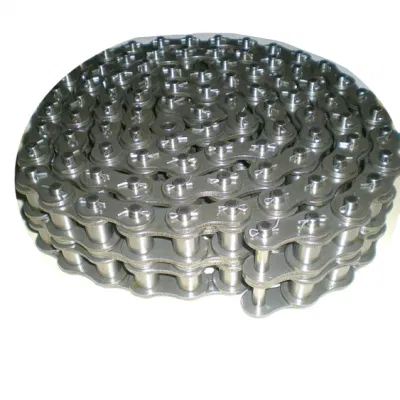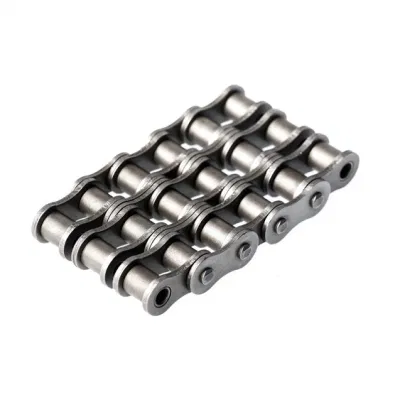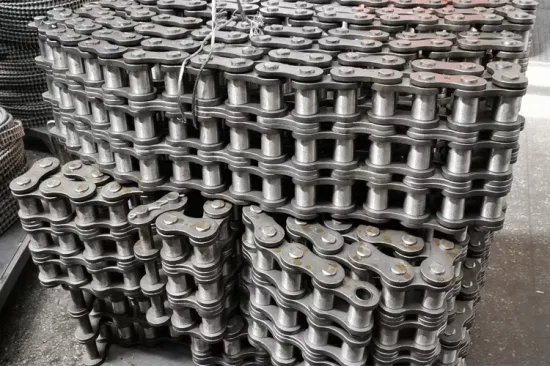Product Description
Product Description
Conveyor Chains
Bush roller chain (used in U type scraper conveyor)
Bush roller chain (used in horizontal scraper conveyor)
Chains adopt high quality medium-carbon alloy steel,chain plate material is 40Mn, pin and roller material is 40Cr.
High quality material and good heat treatment guarantee excellent anti-shearing force and tensile strength during working and have good looking.
Model: GLF For TGSS flat scraper conveyor, install flat scrapper
NOTE: Other specifications which are not listed above can be made to customs’specifications.
Ring Chain
| Drag Conveyor Type | Ring Chain Type | Pitch P(mm) |
Diameter d(mm) |
Length L1(mm) |
Width W(mm) |
Flight Type | Wing Width L(mm) |
Flight Width H(mm) |
| GSS16 | D10-55-13 | 55 | 10 | 74 | 32.5 | HF16 | 148 | 43.5 |
| GSS20 | D10-55-13 | 55 | 10 | 74 | 32.5 | HF20 | 188 | 43.5 |
| GSS25 | D10-55-13 | 55 | 10 | 74 | 32.5 | HF25 | 225 | 43.5 |
| GSS32 | D14-70-18 | 70 | 14 | 95 | 45 | HF32 | 300 | 54.5 |
| GSS40 | D14-70-18 | 70 | 14 | 95 | 45 | HF40 | 382 | 54.5 |
Note: The installation spacing of the nylon scraper is 4 links. We suggest every 4-6pcs of nylon scraper add 1 PU scraper to better remove the material residue in the scraper slot.
Packaging & Shipping
Certifications
Company Profile
Main Product Catalogue
FAQ
Q: Are your manufacturer or trading company?
A: ZheJiang CHINAMFG is a leading and professional manufacturer of grain conveying equipment accessories over 10 years in China.
Q: What is your payment term?
A: Our usual payment is 30%TT in advance, 70%TT before shipment (the bill of landing). For small quantity, we also accept other ways after discussion.
Q: Could i buy sample first or small order and is the sample fee refundable?
A: Of course. We accept sample and small order especially for new customs and of course the sample fee will be refundable when order confirmed.
Q: When can delivery from ordering?
A: The delivery time depend on the quantity you ordered, generally about 15-45 days after deposit of payment.
Q: What is the quality of your products?
A: Quality is our corporate culture, we regard product quality as life of our company. We have achieved a lot of certifications to meet customs requirements. As a factory, we can control all process of production 100% and every single product will be tested qualified before shipping.
Q: How long is the warranty of your product?
A: Our warranty period is usually 1 year. But the warranty period can be extended after discussion and agreement.
| Material: | Stainless Steel |
|---|---|
| Structure: | Roller Chain |
| Surface Treatment: | Polishing |
| Samples: |
US$ 1/Meter
1 Meter(Min.Order) | Order Sample |
|---|
| Customization: |
Available
| Customized Request |
|---|
.shipping-cost-tm .tm-status-off{background: none;padding:0;color: #1470cc}
| Shipping Cost:
Estimated freight per unit. |
about shipping cost and estimated delivery time. |
|---|
| Payment Method: |
|
|---|---|
|
Initial Payment Full Payment |
| Currency: | US$ |
|---|
| Return&refunds: | You can apply for a refund up to 30 days after receipt of the products. |
|---|

How does a bush chain handle shock loads and impacts?
Bush chains are designed to handle shock loads and impacts encountered in various industrial applications. They possess certain features that enable them to withstand these dynamic forces. Here’s a detailed explanation:
1. Robust construction: Bush chains are typically constructed using high-strength materials such as alloy steel, which provide excellent durability and resistance to shock loads and impacts. The chain components, including the pins, bushings, and rollers, are designed to withstand the forces exerted during sudden acceleration, deceleration, or impacts.
2. Precision manufacturing: Bush chains undergo precise manufacturing processes to ensure accurate dimensions and tight tolerances. This precision allows the chain components to fit together properly, reducing the risk of misalignment and wear caused by shock loads and impacts.
3. Proper lubrication: Adequate lubrication is crucial for reducing friction and cushioning the impact forces within the bush chain. Proper lubrication helps to absorb the shock loads and impacts, preventing excessive wear and extending the chain’s service life. Regular lubrication maintenance is essential to ensure optimal performance under such conditions.
4. Impact-resistant design: Some bush chains feature design elements that enhance their ability to handle shock loads and impacts. These may include hardened pins and bushings, impact-resistant rollers, and specialized coatings or surface treatments that increase their resistance to wear and deformation.
5. Proper installation and tensioning: Correct installation and tensioning of the bush chain are critical for its ability to handle shock loads and impacts. Ensuring proper alignment and tension helps distribute the forces evenly across the chain, minimizing stress concentrations and the potential for component failure.
While bush chains are designed to handle shock loads and impacts, it’s important to consider the specific application requirements and consult with chain manufacturers or experts for guidance on selecting the appropriate chain type and ensuring proper maintenance practices. Taking these precautions will help maximize the chain’s performance and longevity under challenging operating conditions.

How do you troubleshoot common issues with bush chains?
Troubleshooting common issues with bush chains involves identifying the problem and taking appropriate corrective actions. Here are some common issues and their troubleshooting steps:
1. Chain Misalignment: If the bush chain is misaligned, it can cause excessive wear, noise, and premature failure. To troubleshoot this issue, check the alignment of the sprockets and adjust them as necessary. Ensure that the chain runs smoothly and evenly on the sprockets without any binding or skipping.
2. Chain Binding: If the chain becomes stuck or binds during operation, it may be due to improper lubrication, debris accumulation, or worn-out components. Start by cleaning the chain and sprockets to remove any debris or contaminants. Lubricate the chain with the recommended lubricant to reduce friction. If the issue persists, inspect the chain for signs of wear and replace any worn-out components.
3. Excessive Chain Wear: Excessive chain wear can lead to elongation, reduced performance, and increased risk of failure. To troubleshoot this issue, measure the chain’s length and compare it to the manufacturer’s specifications. If the chain has elongated beyond the acceptable limits, it needs to be replaced. Additionally, inspect the chain for signs of pin and bushing wear, plate wear, or sprocket wear. Replace any worn components as necessary.
4. Insufficient Lubrication: Inadequate lubrication can result in increased friction, wear, and premature failure of the bush chain. If the chain appears dry or there are signs of insufficient lubrication, apply the appropriate lubricant to the chain according to the manufacturer’s recommendations. Ensure that the lubricant reaches all the critical components of the chain, including the pins, bushings, and rollers.
5. Chain Breakage: Chain breakage can occur due to excessive loads, sudden impacts, or worn-out components. To troubleshoot this issue, inspect the chain for any signs of damaged or broken links. Identify the cause of the breakage, such as overload or impact, and address it accordingly. Replace the broken chain links with a new chain segment and ensure proper installation.
6. Excessive Noise and Vibration: Unusual noise and vibration during chain operation can indicate underlying issues. Inspect the chain for signs of misalignment, worn-out components, or inadequate tension. Address the specific cause by adjusting the alignment, replacing worn parts, or adjusting the tension to reduce noise and vibration.
It’s important to consult the manufacturer’s guidelines and recommendations for troubleshooting specific issues with bush chains. Regular inspection, proper lubrication, and timely maintenance can help prevent common issues and ensure the reliable and efficient operation of the bush chain.

What is a bush chain and how does it work?
A bush chain, also known as a bush roller chain or a bushing chain, is a type of roller chain commonly used in mechanical power transmission systems. It consists of a series of interconnected links, known as bushings, that are joined together by pins. The bushings are cylindrical metal sleeves with internal bearings that rotate on the pins.
The working principle of a bush chain is based on the interaction between the rotating bushings and the teeth of the sprockets. The chain is wrapped around two or more sprockets, with one sprocket being the driver and the other(s) being the driven. As the driver sprocket rotates, it pulls the chain, causing the bushings to rotate on the pins.
Each bushing has an outer surface that comes into contact with the sprocket teeth. The engagement between the sprocket teeth and the bushings’ outer surface creates the driving force, allowing power to be transmitted from the driver sprocket to the driven sprocket(s). This rotational motion transfers torque and enables the movement of various mechanical components or systems connected to the driven sprocket(s).
The bush chain design provides several advantages, including high tensile strength, flexibility, and the ability to transmit power over long distances. The bushings and pins are typically made of hardened steel to ensure durability and resistance to wear. Lubrication is essential to reduce friction and prevent premature wear of the bushings and pins.
Bush chains are widely used in various applications, such as industrial machinery, agricultural equipment, automotive systems, and conveyor systems. They are favored for their reliability, efficiency, and ease of installation. Proper maintenance, including regular lubrication and tension adjustment, is necessary to ensure the smooth operation and longevity of a bush chain.


editor by CX 2023-11-09
